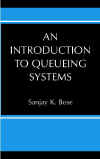
 |
![]()
|
|
v |
|
|
|
ix |
|
|
xi |
|
|
Introduction |
1 |
|
|
Basic Queueing Theory |
9 |
|
Analysis of the M/G/1 Queue in Equilibrium |
55 |
|
|
Advanced Queueing Theory |
89 |
|
Fundamentals of Queueing Networks |
143 |
|
|
Advanced Queueing Networks |
193 |
|
Simulation Techniques for Queues and Queueing Networks |
257 |
|
|
References |
|
283 |
|
Index |
|
285 |
Click on the links above for more detailed information on the contents of individual chapters. Sample sections are also provided.
Please write to skb@ieee.org if you have problems downloading any of the material on this and other linked web pages
![]()
This book is available from Kluwer/Plenum
Publishers . Please visit the publisher's web
site for this book for ordering and other publication information .
![]()
Slide Set 1 (Chapter 1) An Introduction to Queues and Queueing Theory
Slide Set 2 (Sections 2.1 - 2.2) Stochastic Processes, Markov Chains etc.
Slide Set 3 (Sections 2.3 - 2.5) Basic Queueing Theory - I (Analysis of M/M/-/- Type Queues)
Slide Set 4 (Sections 2.6 - 2.10) Basic Queueing Theory - II (Departures, Method of Stages, Batch Arrivals)
Slide Set 5 (Chapter 3) Analysis of the simple M/G/1 Queue (Residual Life, Imbedded Markov Chain)
Slide Set 6 (Additional Notes) Method of Supplementary Variables for the M/G/1 Queue
Slide Set 7 (Sections 4.1 - 4.3) M/G/1 Queue with Vacations and Exceptional First Service
Slide Set 8 (Section 4.4) M/G/1 Queue with Batch Arrivals
Slide Set 9 (Section 4.5) Priority Operation of the M/G/1 Queue
Slide Set 10 (Additional Notes) Analysis of M/M/n/K Queue with Multiple Priorities
Slide Set 11 (Additional Notes) Basic Model of Finite Capacity Single Server M/G/1/K Queue
Slide Set 12 (Additional Notes) The G/M/1, G/G/1, G/G/m, and M/G/m/m Queues
Slide Set 13 (Chapters 5, 6) Queueing Networks - I (Classification and Basic Concepts)
Slide Set 14 (Chapter 5) Open and Closed Jackson Networks
Slide Set 15 (Chapter 5) Analysis of Closed Networks (Convolution and MVA Algorithms)
Slide Set 16 (Chapters 5, 6) Queueing Networks - II
QNAT Slides Slides on the QNAT Package
Slide Set 17 (Chapter 7) Simulation of Queues and Queueing Networks
Slide Set 18 (Section 4.6) Discrete Time Queues
Analysis of a
M/G/1/K queue with vacations - exhaustive service with single/multiple
vacations
Another
look at the M/G/1 queue (includes the Method of Supplementary
Variables)
Analysis of
M/M/n/K queues with preemptive and non-preemptive priorities
![]()
![]()